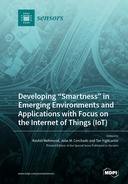Explore

Developing “Smartness” in Emerging Environments and Applications with Focus on the Internet of Things (IoT)
0 Ungluers have
Faved this Work
Login to Fave
This reprint focusses on Smartness, a multidisciplinary topic, which is examined from four perspectives: Sensors, IoT, and Data Generation; Data and Information Processing; Actuation; and Digital Systems and Infrastructure. We see smartness in the way sensing is embedded in a system, the way data and information are processed, how a system interacts internally and with its environment, and whether a system is ubiquitous or limited by space (cloud-based or edge-enabled). This reprint contains a total of 14 chapters, which are grouped according to their areas of application: mobility and transportation, healthcare, industrial environments, and other urban infrastructures. This book covers a range of topics, including mobility; healthcare; image analysis; permeable pavements; solid-waste management; sensor node and gateway architectures; cloud, fog, and edge computing; air-quality monitoring; thermal anomalies and smart helmets in industrial environments; smart airports; smart districts; smart travel choices; sensor cities; artificially intelligent cities; platform urbanism; and more.
This book is included in DOAB.
Why read this book? Have your say.
You must be logged in to comment.
Rights Information
Are you the author or publisher of this work? If so, you can claim it as yours by registering as an Unglue.it rights holder.Downloads
This work has been downloaded 89 times via unglue.it ebook links.
- 89 - pdf (CC BY) at Unglue.it.
Keywords
- 3D microstructure reconstruction
- 6th generation (6G) networks
- Air quality
- Arabic tweets
- Arduino Uno
- artificial intelligence
- artificial intelligence (AI)
- artificially intelligence commons
- artificially intelligent city
- assistive tools
- automatic labeling
- Autonomous driving
- big data
- Bus
- City 4.0
- Climate Change
- Cloud computing
- cloud server
- convolutional neural network
- customized gateway
- customized sensor node
- Data Analytics
- deep learning
- disruptive urban transition
- Distributed AI as a Service (DAIaaS)
- distributed machine learning
- edge computing
- edge-fog-cloud computing
- event detection
- FLoRa simulation
- fog computing
- functional requirements
- generative adversarial networks
- green computing
- Healthcare
- History of engineering & technology
- image registration
- intelligent transportation systems
- internet of everything (IoE)
- Internet of Things
- Internet-of-Things (IoT)
- land-use
- LiDAR
- LoRa range radio
- Machine learning
- microcontroller
- mode choice
- model actionability
- model evaluation
- n/a
- naïve Bayes
- Natural disasters
- obstacle detection
- obstacle recognition
- OHS
- pandemics
- particulate matter (PM10 PM2.5)
- permeable pavement
- PPE
- real time big data
- Reference Architecture
- risk detection
- Road Traffic
- robotics
- sensor city
- sensors
- skin disease diagnosis
- smart airport
- smart app
- smart card
- Smart cities
- Smart city
- smart districts
- Smart Governance
- smart healthcare
- smart mobility
- smart sensor
- smart societies
- smart urban technology
- smart urbanism
- Social media
- social media analytics
- solid waste management
- Spatial Analysis
- support vector machine
- sustainability
- sustainable urban development
- technology giants
- Technology, engineering, agriculture
- Technology: general issues
- TensorFlow
- tiny AI
- tiny ML
- transfer
- transit
- ultrasonic
- Urban Informatics
- visually impaired
Links
DOI: 10.3390/books978-3-0365-6184-4Editions

